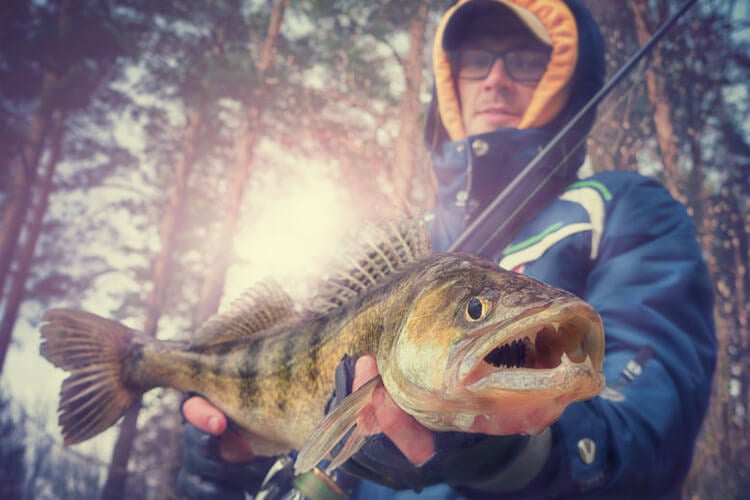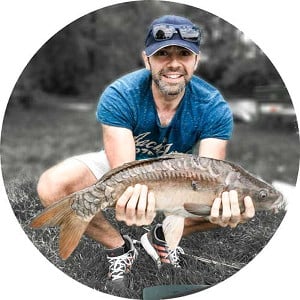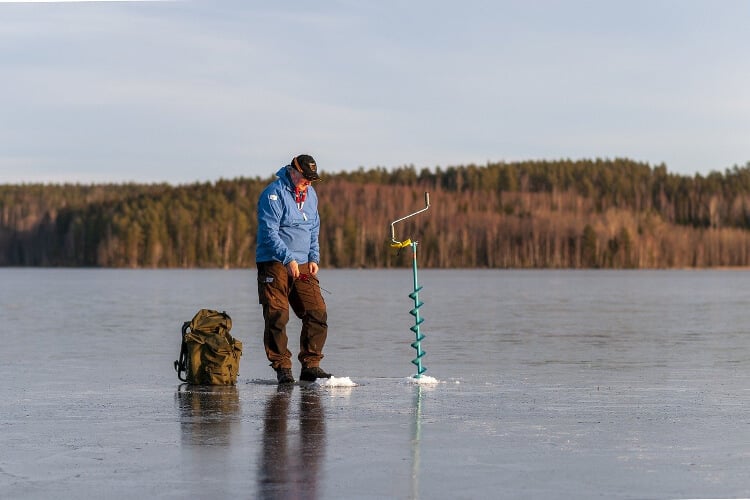A Day's Catch Winneconne, WI | Ice Fishing for Walleyes: 10 BEST Tips of All Time!

Ice fishing for walleye is very popular among winter anglers!
But if it seems that you are not catching any, maybe you are doing something wrong.
Here I will list the best ice fishing for walleye tips which are proven to be effective.
If you are a beginner, use those as a starting point to build up your knowledge end experience.
These tips will also answer some of the frequently asked questions about ice fishing for walleyes.
Tip #1: Pick the Right Ice Fishing Spot for Walleye
Some anglers think that walleyes are inactive and impossible to catch in winter, but the truth is, they are not. You can catch them the same way as in the summer from the shore.
Same as every fish species, walleyes change their usual behavioural patterns in winter.
Early in winter, you have to think about fall transition.
“Early ice” means that walleyes will be deeper in the water, close to large underwater structures. That transition occurred in fall, and during early winter and first ice, that hasn’t changed. Look for areas with steep drop-off, where deep water is very close to shallow areas.
Later in winter, during “late ice”, look for shorelines and locations where streams enter the lake. Warmer water source will attract walleyes which are getting ready for spring.
Search for ridges and structures which are great hiding places for baitfish.
Tip #2: Choose the Best Time of the Day
Ice fishing for walleye can be done through out the day, but the best time would be when the light is changing. Early morning and evening are the best. Activity period is strongest around 1-2 hours around sunrise and sunset.
The same light changing conditions can apply on cloudy days, or times before storms. Absence of bright light will increase the activity and you will notice more bites than during sunny days.

Tip #3: Ice Fishing for Walleye at Night
Walleyes are very active in low light conditions, but you can also fish for walleyes with no light at all.
Try to fish after sunrise in the evening. To attract walleye attention in the light conditions where the fish can’t see very well, you will have to use proper lures.
Try using rattle spoons that produce a lot if vibration.
Your lure presentation and jigging have to be more aggressive. In addition, you can try to use glow lures. Those will illuminate underwater and attract a hungry walleye.
Finding walleyes in dark can be a hard task, so think about some electronic help. There are different fish finders available on the market and some of them are made to be used under ice.
Tip #4: The Best Depth to Ice Fish for Walleye
Choosing the right depth can be tricky, and the depth has to be in correlation with the location.
It also depends on a specific location ...
In clear lakes, you will find walleyes between 10 and 20 feet (3-6 meters).
This deeper location should be near the steep underwater incline where the water is 3 – 6 feet deep (1-2 meters).
In deeper lakes, try to find underwater areas where the shallow part is around 8-10 feet, while adjacent deeper areas go as deep as 30 feet (10 meters).
Finding the right depth doesn’t mean that the walleye will be there. There must be underwater structures and usual hiding places which are attractive to walleyes ...
Tip #5: Use Only the BEST Bait (Lure) for Walleyes
Choosing the right bait is essential. I already mentioned glowing lures for night fishing, but what about daytime lures?
Natural baits like night-crawlers or minnows may not be as effective as you would assume.
In winter, a lot of vibration and movement is necessary to attract the walleye.
The best lure choice are jigging lures, jigging lures with swim action, jig heads and small rattle spoons.
And your jigging technique has to be more aggressive than in summer!
If you want to maximize your success, try combining these lures with small pieces of natural bait, to add some smell and taste.
Attach a small night crawler or similar bait alongside your lure and you will have more success.
If live bait is allowed, try using leaches, shiners, minnows or night crawlers, depending on which one is available to you. Don't forget that walleye teeth are really strong!
Tip #6: Choose the Right Colors
Except for choosing the right lure type, you have to choose the right colour.
And of course, always have a few different ones in your tackle box to be able to change it on the spot.
Walleyes can perceive certain colours better than others. According to a certain scientific research, walleyes can perceive red, orange and yellow better than other colours. After those three, the next best choice would be green.
Other colours, especially those in the blue range are not perceived by walleyes and those colours seem dark to them.
According to water clarity, choose a colour from red or orange spectrum which can be lighter or brighter.
Tip #7: Attracting Walleye in the Right Way
Finding a good spot, together with a good lure, is just one part of the job. Another important thing you have to do is to attract walleyes.
In order to get their attention, you will have to use the right bait presentation method.
In winter, walleyes can be a bit slower and your lure has to seem attractive.
Aggressive presentation, as already mentioned, is the key. Walleyes are predators, and they will naturally hunt prey that is positioned above them. When you present your lure, make sure it is not in line with the fish or below it.
Work your bait to attract the fish. When the fish comes close, stop with those hard motions and let the lure slow down. It will look like an injured fish and the walleye will bite.
Proper presentation is very important and it is very logical. Biology of a walleye will work in your favour.

Tip #8: Use the Best Rig
If you can use two fishing rods, try the following. Set up one “dead one” and one jigging.
Dead one should be simple, with a float and a live bait, such as minnow.
Jigging one should be equipped with a vibration producing lure. Work that one to attract walleyes. When the walleye arrives attracted by the noise, there is a chance it will go for your lure, but it may also choose the live minnow. This will definitely increase your chances.
If you are using just one rod, use a slip bobber rig. This option is also good for beginners.
Slip bobber rig enable you to present the bait at any depth. Thread the slip tie, pull it in place, add the bead and the float. Attach a split shoote about 1 foot (30 centimetres) above the hook. Adjust the depth so that the bait is above the bottom and the float is standing upright.
Tip #9: Use the Right Tackle and Equipment
Walleyes can be caught on different equipment and it depends on a location, technique and year time.
In winter, you should choose a well-balanced, medium powered, fast action rod, about 28 inches (70 centimetres) long.
Choose a fishing reel that has good and dependable drag option that works well under any load.
You can use spinning reel if you don’t want/don’t have an ice fishing one. 1000 size should be enough for ice fishing.
When choosing a line, and thinking about ice fishing line vs regular line, buy the ice one.
Monofilament line in the range of 6 to 8 pounds should be enough, but make sure that you choose those that can withstand icy conditions. Mono line is a bit stretchy so it lowers the shock and stress on the line when the fish bites aggressively. Those made for ice fishing are less visible and more abrasion resistant, among other advantages.
When adding leaders, use a swivel to eliminate twists.
Tip #10: Drill Multiple Ice Fishing Holes (Contour fishing)
When ice fishing for walleye, don’t be lazy.
Arrive early and find a spot as described in previous tips. When you find a spot, drill several holes along different depths.
Drill in the deep part, then drill on the transition area, and then drill the shallower part. You have to have these holes ready so that you can instantly change the spot if necessary.
Even better, suspend your live baits under tip ups for ice fishing! It is an excellent method to cover more water at once and fish multiple holes at the same time.
Some anglers like to use tip downs for ice fishing, but those are more suitable for smaller fish species. Use them only if walleyes in your area are particularly small.
Drill 3-5 holes per location. BUT, don’t drill them too close and use a zig-zag pattern, not in-line.
When walleyes become active and start to feed aggressively, they will swim from deep to shallow water, and back. You have to recognize this time and move together with walleyes.
Drilling a hole or two is not sufficient.

Conclusion
There are numerous ice fishing for walleyes tips, and every angler has certain opinions about it.
However, not all tips and advices can be applied and practiced everywhere and they will not work the same on all waters.
Ice fishing for walleye tips stated here can be used in any water with just minor adjustments on the spot. Get to know the local waters and try to change your approach by using methods stated here. You will be surprised how a proper lure or a bait presentation can change the outcome.
